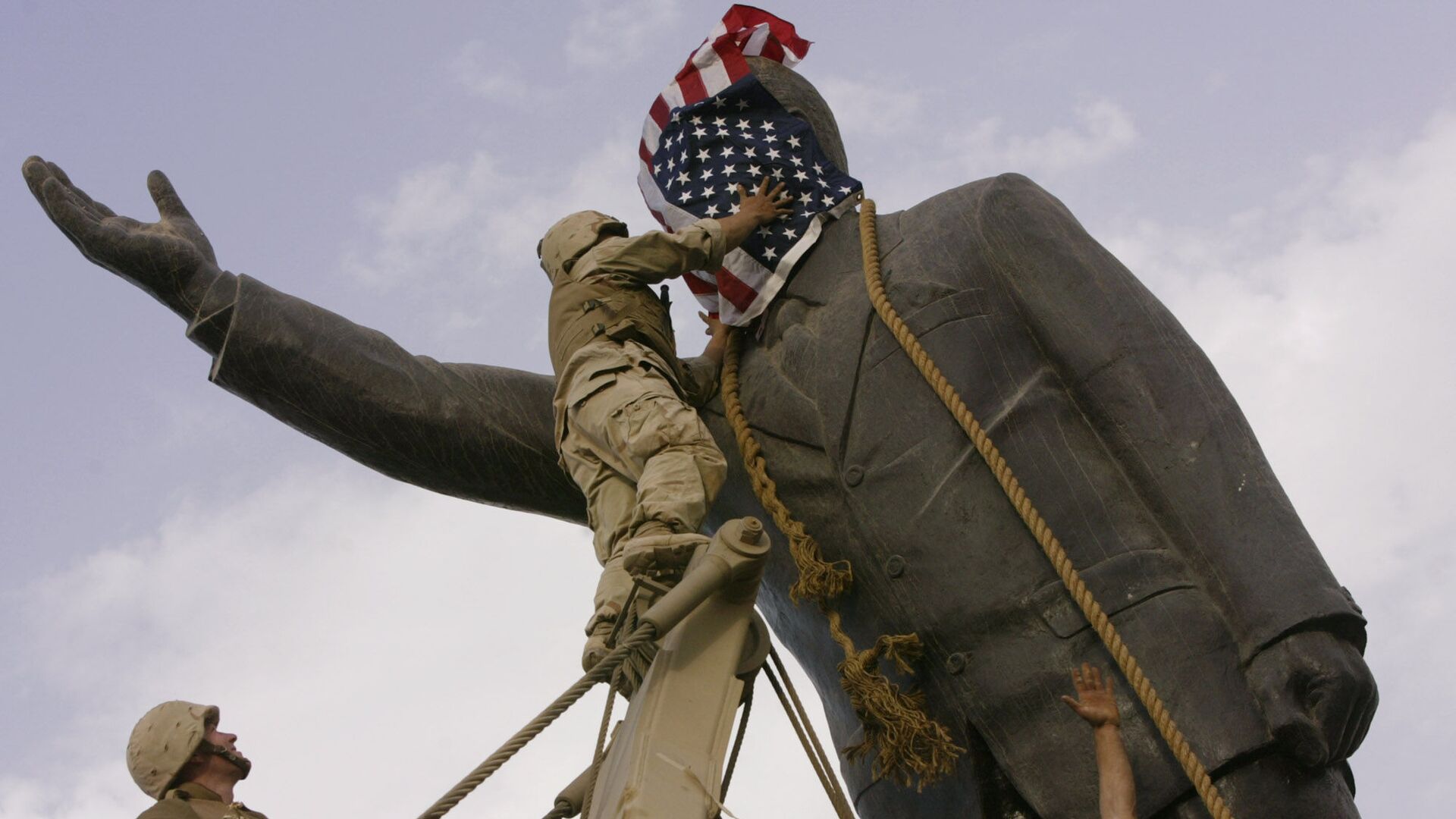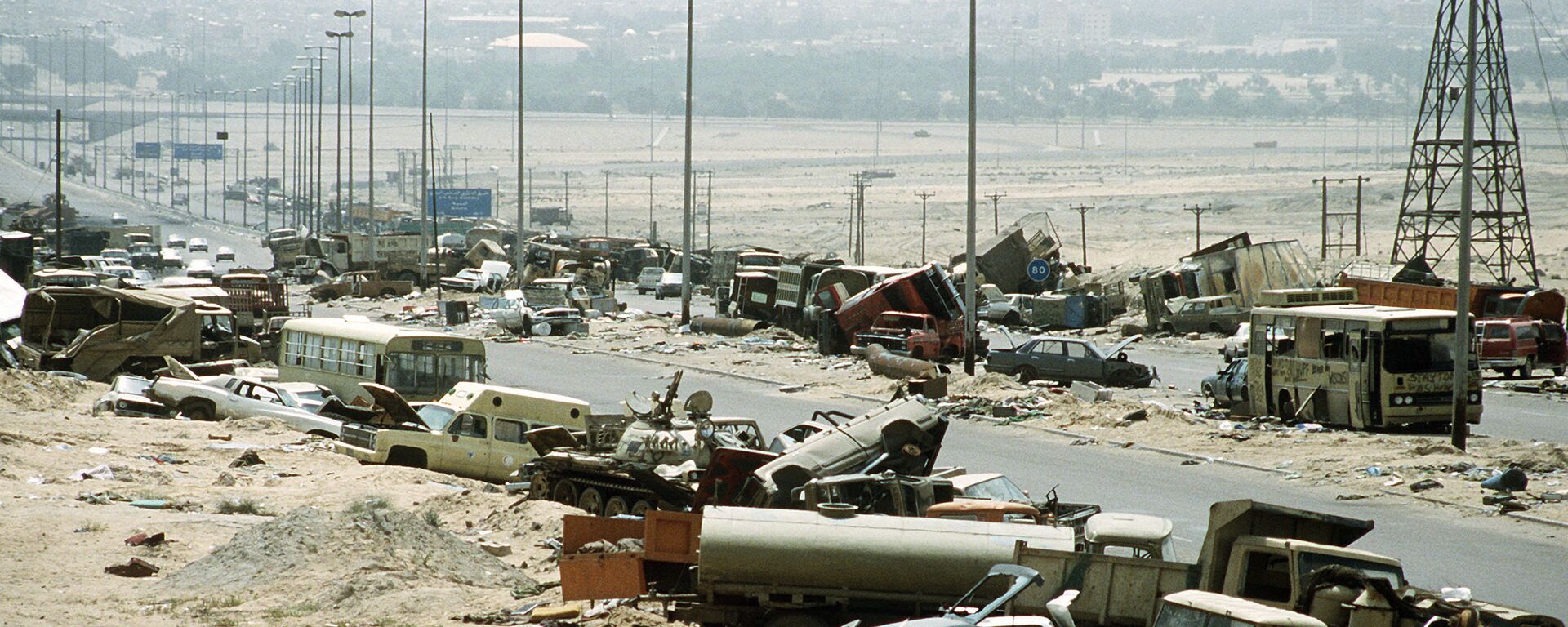Recalling US Conquests, Crusades and Coups as Congress Mulls ‘Aggressor State’ Label Against Russia
18:46 GMT 21.12.2022 (Updated: 17:04 GMT 31.07.2023)

© AP Photo / Jerome Delay
Subscribe
Instead of focusing on pressing problems such as an inflation crunch, sky-high energy costs, a national debt surpassing $31 trillion and an unprecedented crisis at its southern border, US lawmakers have signaled other priorities: slapping a meaningless ‘aggressor state’ label on Russia.
Before Ukrainian President Volodymyr Zelensky’s arrival in Washington, DC on Wednesday for talks with President Biden, US lawmakers from both sides of the aisle worked fastidiously to try to put together a bill labeling Russia as an “aggressor state.”
The bill was tabled after a separate piece of legislation sponsored by hawkish South Carolina Republican Senator Lindsey Graham to label Russia a “state sponsor of terrorism” was slapped down by the White House amid fears of “unintended consequences,” such as the total breakdown in Russia-US relations.
Instead, US media have reported that a softer “aggressor state” designation would provide the White House with additional sanctions powers to target Russian officials without the hassle and dangerous tensions that a “terror sponsor” label would entail.
“Zelensky asked for the State Sponsor of Terror designation and instead the Biden administration has told him it won’t support it, but have concocted an alternative designation that doesn’t even exist under US domestic or international law – there is no legal basis for it,” a congressional staffer familiar with the ‘aggressor state’ bill talks grumbled of the new bill. “It’s a half-baked PR measure that won’t do anything to punish Russia, nor help the Ukrainian people,” they added.
Starting With the Man in the Mirror
The bill reportedly allows the president to designate “any foreign country” an “aggressor state” if it is deemed to have engaged in “aggression against Ukraine,” and threatens sanctions against persons deemed responsible or complicit in such “aggression.” Leaving aside the dubious nature of the “aggression” claims, critics of the bill have called it “redundant,” pointing out that the West has already sanctioned hundreds of Russian officials, businessmen, journalists and others, and is running out of sanctions they could slap on the Russian state without further harming US and allied interests.
As to the terms “aggression” and “aggressor,” the bill does not specify how Russia, which spent years together with France and Germany engaged in diplomatic efforts to try to peacefully resolve the Ukrainian crisis sparked by a US-backed coup before finally launching its military operation in February 2022, is the “aggressor” in the situation. As President Putin said when ordering the start of the military operation, its main purpose was to protect the people of the Donbass.
It’s rich of Washington to accuse Moscow of “aggression,” given that according to the US government’s own calculations, the United States has launched some 469 military interventions since 1798, 251 of them since the 1991 collapse of the Soviet Union and the so-called end of the Cold War. And that’s not even counting military “covert actions,” CIA- and State Department-backed coup and color revolution plots.
Writing about these 400+ interventions in detail could fill up a library, so below are just a few of the most brazen examples of US aggression, and limited to the past 25 years.
Sudan/Afghanistan 1998: On August 20, 1998, hounded by the press and congressional Republicans over the Monica Lewinsky sex scandal, President Bill Clinton ordered a series of cruise missile strikes against suspected al-Qaeda* targets in Sudan and Afghanistan. In Sudan, the US hit a pharmaceutical factory suspected of producing VX nerve gas, killing one factory employee and wounding eleven other people. The US later admitted that the plant was not producing any weapons of mass destruction. Instead, it turned out to be the only factory of its kind in Sudan producing lifesaving tuberculosis drugs and veterinary medicines for use against parasites in animal husbandry – one of the leading causes of infant mortality in the African nation. The Afghanistan strike was said to have hit an al-Qaeda training camp, killing between 6-50 terrorists. The Taliban** alleged that the attack killed only civilians.
Iraq 1998: Between December 16-23, 1998, the United States and Britain carried out a series of air and cruise missile strikes on Iraq, destroying military infrastructure, including suspected WMD sites. A British whistleblower later revealed that the coalition did not actually have any degree of certainty about the use of any of the sites struck for WMD purposes. The bombings killed or injured dozens of Iraqi troops and an unknown number of civilians, and caused extensive damage to the country’s already sapped and dilapidated civilian infrastructure. The strikes were followed up by a tightening of the US coalition’s no fly zone over northern and southern Iraq, which killed as many as 1,400 civilians in the twelve years it was in force between 1991 and 2003.
Yugoslavia 1999: From March 24 until June 10, 1999, NATO conducted an extensive bombing campaign against the rump state of Yugoslavia (modern-day Serbia and Montenegro). The 78-day campaign of air and cruise missile strikes, which the alliance promised would concentrate on military targets, killed up to 5,000 civilians, razed the Balkan nation’s infrastructure and economy, and deliberately bombed the Chinese Embassy in Belgrade, killing three Chinese nationals. The bombings also contaminated wide swathes of territory with cancer-causing radioactive agents spread by 15 ton of depleted uranium, sending cancer rates, infertility, mental disorders and a host or autoimmune diseases through the roof. The crisis the bombings was supposed to 'resolve' – the Kosovar Albanian question, was never dealt with, and continues to smolder to this day.
Afghanistan 2001: On October 7, 2001, less than a month after the 9/11 terror attacks in New York and Washington, DC, the United States launched Tomahawk cruise missiles at suspected al-Qaeda targets in Afghanistan, signaling the start to ‘Operation Enduring Freedom’. Between November and December 2001, US and its allies, including the Northern Alliance, rapidly advanced through the country, pushing the Taliban into remote rural areas and neighboring Pakistan. The invasion of Afghanistan signaled the start of long and bloody occupation of the country which would last nearly 20 years, cost US taxpayers $2.2 trillion, and lead to the deaths of over 200,000 people, including more than 3,500 US and coalition troops. The misadventure culminated in the humiliating collapse of Afghanistan’s Western-backed government and NATO-trained army in ten days in August 2021.
Iraq 2003: After slapping together a justification for invading Iraq – WMDs, the US attacked the country on March 20, 2003, with President George W. Bush moving to ‘finish the job’ that his father, President George H.W. Bush, decided not to risk during the Gulf War in 1991. The invasion went out without a hitch, with the US and its allies completing the occupation of the country by May 1, 2003, with a death count of 196 US, coalition and Kurdish Peshmerga troops, 45,000 Iraqi soldiers and over 7,200 Iraqi civilians. WMDs were never found. The post-war occupation of Iraq would prove one of the bloodiest military conflicts of the 21st century, with The Lancet’s peer reviewed study of the impacts of the war concluding that the conflict caused nearly 655,000 excess deaths by 2006 alone. As in Yugoslavia, the US and its allies liberally used depleted uranium munitions in Iraq. Earlier this year, Iraqi expert in radioactive pollution Souad al-Azzawi told Sputnik that over 1.2 million Iraqis had been exposed to toxic pollutants from the weapons. The use of DU has resulted in an otherwise inexplicable spike in cancers, other illnesses, and birth defects. The invasion also ultimately gave rise to ISIS (Daesh).*
Libya 2011: Between March 19 and October 31, 2011, the United States, 13 other NATO powers, Sweden, Jordan, Qatar and the UAE waged a months-long bombing campaign against Libyan government forces loyal to Libyan leader Muammar Gaddafi. The campaign, launched in the wake of the so-called ‘Arab Spring’ protests and uprising across the Arab World, was approved by the UN Security Council as a no-fly zone that was supposed to prevent Gaddafi’s forces from using their air superiority to attack rebels. However, it quickly turned into an anti-Gaddafi turkey shoot, indiscriminately targeting Libya’s military equipment and troops. The campaign succeeded, Gaddafi was captured, sodomized and murdered on camera by militants (to claps of joy and laughter by then-US Secretary of State Hillary Clinton) and Libya was transformed from the safest and most prosperous nation in Africa to a failed state teeming with terrorists, human smugglers and open-air slave markets. The country remains divided to this day.
Color Revolutions and Covert Wars: In addition to the use of naked force, the US has deployed its ‘soft power’ via color revolutions – a series of regime-change operations across the post-Soviet space, the Middle East and Latin America. The list of color revolutions and attempted color revolutions in the past two decades is too extensive to detail, but include Yugoslavia, Georgia, Ukraine (2004), Iraq, Kyrgyzstan, Lebanon, Belarus (2006), Myanmar, Malaysia, Moldova, Iran, Kyrgyzstan, Tunisia, Egypt, Yemen, China, Russia (2011), Ukraine (2014), Macedonia, Armenia, Bolivia, Venezuela, Belarus (2020) and Kazakhstan (January 2022). These have been complemented by secret US-backed wars in a number of countries, including Syria (since 2011), Yemen, and Somalia. The latter feature US aid to rebels, drone strikes, and the provision of vast quantities of US arms to allies.
With these details in mind, it's the height of irony and hypocrisy for Washington to have the nerve to try to label another country an ‘aggressor’.
* A terrorist group outlawed in Russia and many other countries.
** A group under United Nations sanctions for terrorist activities.



